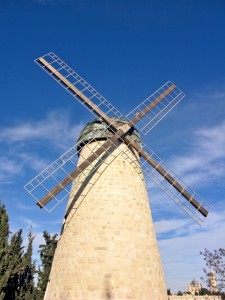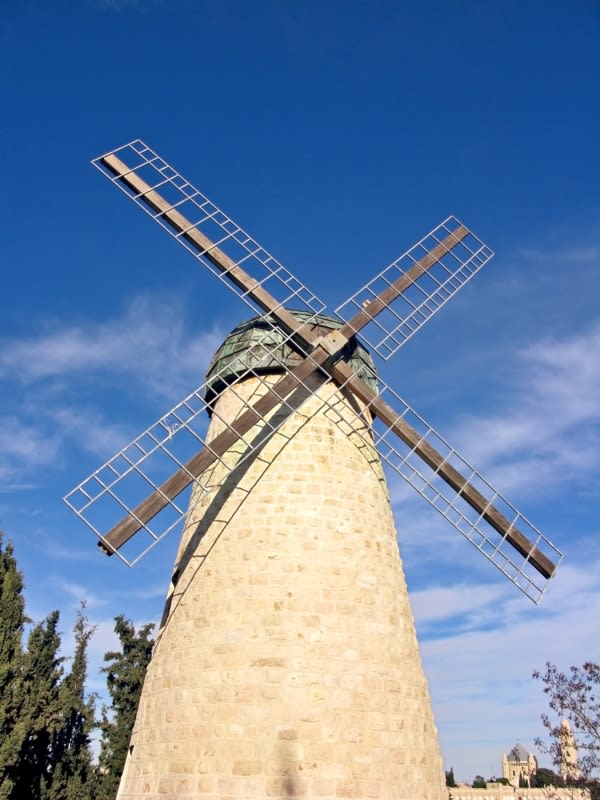In honor of Jerusalem Day, May 8, 2013
Dark against a bright blue summer sky, the sails of the Montefiore windmill were stamped on every Jerusalemite’s consciousness. Forever fixed, unmoving, stark protrusions on the Jerusalem skyline. Except that now they have moved – and if all goes according to plan, they will go on moving, turning and turning as a real windmill should.
The Jerusalem Foundation has spearheaded the recent flurry of activity surrounding the  windmill, removing the sails and dome of the century-old structure in order to restore them to their original size, color, and functionality. The gray dome and sails, the result of a hasty restoration in 1968, have been replaced with a Kentish-style cap and white canvas sails similar to the originals made by the Holman brothers, millwrights from Canterbury, in 1857. In addition to the original fantail, which allowed the structure to be turned into the wind, a motor provides backup, enabling the newly restored windmill to grind flour regardless of weather conditions. There are even plans to sell the flour in an adjacent tourist facility.
windmill, removing the sails and dome of the century-old structure in order to restore them to their original size, color, and functionality. The gray dome and sails, the result of a hasty restoration in 1968, have been replaced with a Kentish-style cap and white canvas sails similar to the originals made by the Holman brothers, millwrights from Canterbury, in 1857. In addition to the original fantail, which allowed the structure to be turned into the wind, a motor provides backup, enabling the newly restored windmill to grind flour regardless of weather conditions. There are even plans to sell the flour in an adjacent tourist facility.
After Sir Moses Montefiore hatched his original plan of providing employment as well as cheaper flour for the Jewish population of Jerusalem, which was living on Diaspora handouts (known as the Haluka, or community stipend), the windmill parts were constructed in Kent and then shipped to Jaffa. There they were loaded onto camels and carefully conveyed over the hills to Jerusalem, where evidently they all arrived intact, to be assembled under the supervision of Thomas and Charles Holman.
Apparently, the rumors that the windmill never functioned properly for lack of wind are only hearsay. The entire cap could be turned and the speed of the sails adjusted to catch the least breath of wind – and to avoid damage by stronger gusts. Fifteen meters high, the windmill was the tallest structure in Jerusalem when it was built, and posed a serious threat to the local Arab monopoly on flour. Fearing that the new windmill would ruin their income, the Arabs even brought in a Muslim holy man to curse it. After the mill withstood the first storms that winter, they concluded – according to the local daily Ha-maggid on 7 Shevat 1859 – that the building was “a work of Satan, who would support it with all his might,” while the Jews “praised it as a gift from the Lord, and blessed God and Sir Montefiore, whose faithful loving-kindness had bestowed it upon them.”
Gazing at the windmill during the strained period leading up to independence in 1948, Alan Cunningham, the last British high commissioner of Palestine, realized that the Jewish paramilitary Hagana had set up an observation post in the Kentish cap. In an operation aptly named “Operation Don Quixote,” he had it blown up. After the fall of the Old City in 1948, the windmill was located on the edge of no-man’s-land, abandoned and sailless. Modern, steam-powered mills had made its technology redundant years before, and it had stood idle since a lack of spare parts had put it out of commission in 1891.
But now the windmill is ready to go again. Five million dollars raised by the Dutch organization Christians for Israel have paid for the new floors, sails, cap, and machinery built by millwright Willem Dijkstra in Sloten, the Netherlands, in cooperation with Dutch construction company Lont and British millwright Vincent Pargeter. The parts were shipped to Israel and reassembled on site.
The interior of the windmill will be divided into the four floors of a traditional mill: the meal floor, where the flour will be collected; the mill floor, housing the actual millstones; the bin floor, where sacks of wheat awaiting grinding will be stored; and on the top level, the dust floor or “engine room.” The exhibition of Montefiore memorabilia previously on display will be replaced by a film describing the building of the windmill and the 19th-century expansion of Jerusalem beyond the Old City. A project is afoot involving the Konrad Adenhauer Conference Center and Mishkenot Sha’ananim for a new Montefiore exhibition commemorating his trip to Israel and the treasures he bequeathed to the Spanish and Portuguese Jewish community in England. Perhaps it could be funded by the income from the boutique flour produced by the Montefiore windmill.
Reprinted by kind permission of Segula Magazine. For the full illustrated article go to: www.segulamag.com.
The words of this author reflect his/her own opinions and do not necessarily represent the official position of the Orthodox Union.
